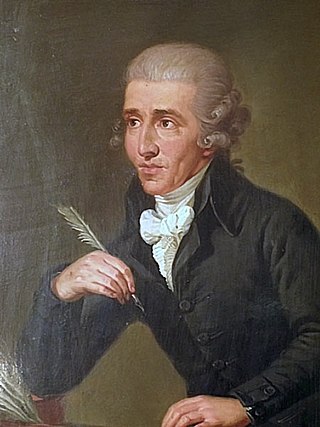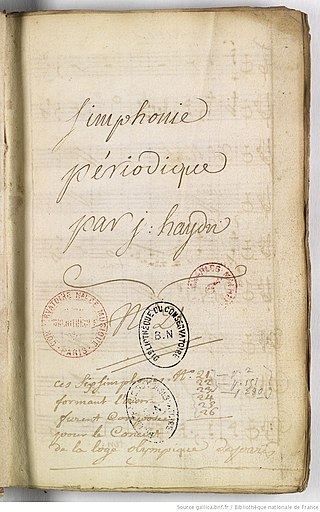Related Research Articles

Franz Joseph Haydn was an Austrian composer of the Classical period. He was instrumental in the development of chamber music such as the string quartet and piano trio. His contributions to musical form have led him to be called "Father of the Symphony" and "Father of the String Quartet".

A symphony is an extended musical composition in Western classical music, most often for orchestra. Although the term has had many meanings from its origins in the ancient Greek era, by the late 18th century the word had taken on the meaning common today: a work usually consisting of multiple distinct sections or movements, often four, with the first movement in sonata form. Symphonies are almost always scored for an orchestra consisting of a string section, brass, woodwind, and percussion instruments which altogether number about 30 to 100 musicians. Symphonies are notated in a musical score, which contains all the instrument parts. Orchestral musicians play from parts which contain just the notated music for their own instrument. Some symphonies also contain vocal parts.

The term string quartet can refer to either a type of musical composition or a group of four people who play them. Many composers from the mid-18th century onwards wrote string quartets. The associated musical ensemble consists of two violinists, a violist, and a cellist.

Johann Michael Haydn was an Austrian composer of the Classical period, the younger brother of Joseph Haydn.

Joseph Haydn's Symphony No. 45 in F♯ minor, known as the "Farewell" Symphony, is a symphony dated 1772 on the autograph score. A typical performance of the symphony lasts around twenty-five minutes.
An urtext edition, of a work of classical music is a printed version intended to reproduce the original intention of the composer as exactly as possible, without any added or changed material. Other kinds of editions distinct from urtext are facsimile and interpretive editions, discussed below.
C major is a major scale based on C, consisting of the pitches C, D, E, F, G, A, and B. C major is one of the most common keys used in music. Its key signature has no flats or sharps. Its relative minor is A minor and its parallel minor is C minor.

Symphony No. 40 in G minor, K. 550 was written by Wolfgang Amadeus Mozart in 1788. It is sometimes referred to as the "Great G minor symphony", to distinguish it from the "Little G minor symphony", No. 25. The two are the only extant minor key symphonies Mozart wrote.
In music theory of musical form, through-composed music is a continuous, non-sectional, and non-repetitive piece of music. The term is typically used to describe songs, but can also apply to instrumental music.

Gottfried Freiherr van Swieten was a Dutch-born Austrian diplomat, librarian, and government official who served the Holy Roman Empire during the 18th century. He was an enthusiastic amateur musician and is best remembered today as the patron of several great composers of the Classical era, including Joseph Haydn, Wolfgang Amadeus Mozart, and Ludwig van Beethoven.
Cyclic form is a technique of musical construction, involving multiple sections or movements, in which a theme, melody, or thematic material occurs in more than one movement as a unifying device. Sometimes a theme may occur at the beginning and end ; other times a theme occurs in a different guise in every part.
The composer Joseph Haydn is sometimes given the nickname "Papa" Haydn. The practice began in Haydn's lifetime and has continued to the present day.
Elaine Rochelle Sisman is an American musicologist. The Anne Parsons Bender Professor of Music at Columbia University, Sisman specializes in music, rhetoric, and aesthetics of the 18th and 19th centuries, and has written on such topics as memory and invention in late Beethoven, ideas of pathétique and fantasia around 1800, Haydn's theater symphonies, the sublime in Mozart's music, and Brahms's slow movements. She is the author of Haydn and the Classical Variation and Mozart: The 'Jupiter' Symphony and editor of Haydn and His World. Her monograph-length article on "variations" appears in the revised New Grove Dictionary of Music and Musicians, and she is at work on studies of music and melancholy, of Don Giovanni, and of the opus-concept in the eighteenth century.

The Paris symphonies are a group of six symphonies written by Joseph Haydn commissioned by the Chevalier de Saint-Georges, music director of the orchestra the Concert de la Loge Olympique, on behalf of its sponsor, Count D'Ogny, Grandmaster of the Masonic Loge Olympique. Beginning on 11 January 1786, the symphonies were performed by the Olympique in the Salle des Gardes du Corps of the Tuileries, conducted by Saint-Georges.

The composers Wolfgang Amadeus Mozart (1756–1791) and Joseph Haydn (1732–1809) were friends. Their relationship is not very well documented, but the evidence that they enjoyed each other's company is strong. Six string quartets by Mozart are dedicated to Haydn.
Count Karl Joseph of Morzin (1717–1783) was a Bohemian aristocrat from the Morzin family, remembered today as the first person to employ the composer Joseph Haydn as his Kapellmeister, or music director. The first few of Haydn's many symphonies were written for the Count.

Joseph Haydn's Symphony No. 31 in D major, Hob. I/31, was composed in 1765 for Haydn's patron Nikolaus Esterházy. It is nicknamed the "Hornsignal Symphony", because it gives a prominent role to an unusually large horn section of four players. Probably because of its prominent obbligato writing for the horns, in Paris, the publisher Sieber published this symphony as a "symphonie concertante" around 1785.

The Symphony No. 51 in B♭ major, Hoboken I/51, is a symphony by Joseph Haydn, written in either 1773 or 1774, although the exact dating remains ambiguous.

Joseph Haydn wrote as many as 123 trios for the unusual combination of baryton, viola and cello, and three further trios for baryton, cello and violin are considered part of the series. As Sisman notes, they are the “most intensively cultivated genre” of Haydn’s early career.

The name of the composer Joseph Haydn had many forms, following customs of naming prevalent in his time.
References
- Jones, David Wyn (1993) Review of Webster (1991). Journal of the Royal Musical Association, Vol. 118, No. 1. (1993), pp. 147–151. Available on JSTOR. A sympathetic and appreciative review of Webster's Farewell Symphony book by another leading Haydn scholar; it defends, in part, Rosen's views.
- Hunter, Mary and Richard Will (2014) Engaging Haydn: Culture, Context, and Criticism. Cambridge: Cambridge University Press.